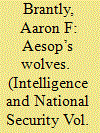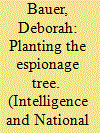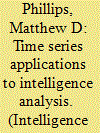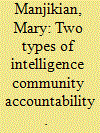|
|
|
Sort Order |
|
|
|
Items / Page
|
|
|
|
|
|
|
| Srl | Item |
| 1 |
ID:
145587


|
|
|
|
|
| Summary/Abstract |
Appearances in cyberspace are deceptive and problematic. Deception in the cyber domain poses an immensely difficult challenge for states to differentiate between espionage activities in cyberspace and cyber attacks. The inability to distinguish between cyber activities places US cyber infrastructure in a perilous position and increases the possibility of a disproportionate or inadequate response to cyber incidents. This paper uses case analysis to examine the characteristics associated with the tools and decisions related to cyber espionage and cyber attacks to develop a framework for distinction leveraging epidemiological models for combating disease.
|
|
|
|
|
|
|
|
|
|
|
|
|
|
|
|
| 2 |
ID:
145589


|
|
|
|
|
| Summary/Abstract |
Tibor Eckhardt, a Hungarian émigré, was a key player in American intelligence operations regarding Hungary during World War II and the early Cold War. He worked closely with a secretive American intelligence organization headed by John Grombach, an American intelligence officer who was a vehement opponent of the CIA. Though Eckhardt and Grombach shared concerns about the CIA, they were also forced to cooperate with it. Eckhardt’s endeavors and those of the many Hungarians whose intelligence work he coordinated were ultimately futile. Hence, they were representative of the efforts of freedom-loving Hungarians to liberate their country during the Cold War.
|
|
|
|
|
|
|
|
|
|
|
|
|
|
|
|
| 3 |
ID:
145590


|
|
|
|
|
| Summary/Abstract |
This article critically examines allegations that Hŭngnam, North Korea, served as a transwar site of nuclear weapons research conducted first by Imperial Japan during World War II, then by the Soviet Union in the postwar period, and subsequently by North Korea itself. Rumors of ‘nuclear research’ being conducted there likely derived from and were conflated with reports of secretive efforts by these parties to prospect for, to mine, and to dress uranium-bearing ores in the surrounding area. The article presents new information from recently declassified CIA records and current Russian research.
|
|
|
|
|
|
|
|
|
|
|
|
|
|
|
|
| 4 |
ID:
145586


|
|
|
|
|
| Summary/Abstract |
Intelligence in France evolved as it professionalized at the end of the nineteenth century, led by determined individuals within the French army. However, in the centuries prior to the professionalization of espionage and counterespionage, military men rejected intelligence, viewing the practice with skepticism and disdain. This article asserts that there was a change in views towards espionage, particularly among the military, beginning in the middle of the nineteenth century. As the army went from eschewing intelligence to embracing it and taking the lead in its practice, the nature of intelligence work in France consequently reflected the goals and aims of the army, prioritizing military intelligence over others.
|
|
|
|
|
|
|
|
|
|
|
|
|
|
|
|
| 5 |
ID:
145593


|
|
|
|
|
| Summary/Abstract |
In the nearly 15 years since the events of 11 September 2001, the Federal Bureau of Investigation (FBI) has undertaken a succession of efforts to become an agency capable of fulfilling the intelligence functions with which it has been entrusted. However, historically, the FBI’s experience with intelligence has been reactive due to a law enforcement culture that closed cases rather than identified ways to keep opportunities for collection open, as well as bureaucratic wariness due to the differing expectations from one Presidential administration to the next. The Threat Review and Prioritization (TRP) process is the most recent iteration of the Bureau’s attempt to organize as an intelligence service. However, TRP is informed not by a mission of developing intelligence that will help to disrupt emerging threats or exploit opportunities at both the strategic (policymaking) and tactical (arrests), but instead reactively focuses on the threats which have become fully manifest within the FBI’s own domain. TRP leaves the US at a disadvantage vis-à-vis state and non-state adversaries and competitors. Organizationally, it institutionalizes the shortcomings of reactivity and insularity that were the unfortunate characteristics of the pre-9/11 FBI.
|
|
|
|
|
|
|
|
|
|
|
|
|
|
|
|
| 6 |
ID:
145591


|
|
|
|
|
| Summary/Abstract |
The scale of lethal violence in Mexico seen in the past decade has been a pressing concern for both Mexican and US officials, including law enforcement organizations, intelligence agencies, and policy makers. With much of the homicides being a result of the trafficking of illegal drugs, it has been suggested that the homicides in Mexico follow seasonal patterns tied to the drug trade, specifically to the cultivation of heroin. In this paper, conventional econometric time series methods are applied to test this hypothesis. Results demonstrate that not only do the drug-related homicides in Mexico display evidence of seasonality, but also that seasonality appears empirically related to the heroin trade. The paper makes the larger argument that time series and other statistical methods are an untapped resource that can complement standard intelligence analysis to support defensible judgments based on the scientific method of inquiry. However, a fuller integration of statistics and traditional analysis would require sufficient support structures be developed to encourage and promote such analysis.
|
|
|
|
|
|
|
|
|
|
|
|
|
|
|
|
| 7 |
ID:
145588


|
|
|
|
|
| Summary/Abstract |
Most academic writing on accountability in intelligence organizations presents a bureaucratic politics model which describes investigations and hearings as turf wars between competing organizations and interests. However, within public administration, a second model of organizational accountability exists. In this model, hearings and investigations are not wars over resources, but rather attempts to clarify the organization’s mission and identity. In analyzing transcripts from the 1975 Church Committee Hearings, we can find evidence that the investigation in fact included both types of accountability exercises. Hearings sought both to discipline wayward agencies and to help all parties understand the events which occurred and what these events meant for the identities of the agencies involved, within the context of a democratic society.
|
|
|
|
|
|
|
|
|
|
|
|
|
|
|
|
| 8 |
ID:
145592


|
|
|
|
|
| Summary/Abstract |
After 9/11 the US Government tried to ‘fix’ intelligence by adopting the Intelligence Reform and Terrorism Prevention Act (IRTPA). Resources increased and, to varying degrees, performance improved – particularly in counterterrorism. This article, however, argues that the constellation of Intelligence Community authorities and organizations, either created or left in place by the IRTPA, coupled with the challenges of a complex security environment, leaves us ill-prepared to deal with the Country’s twenty-first century intelligence requirements. Should that critique prove accurate, and should future intelligence failure(s) be judged strategically and politically unacceptable, the second half of the article provides a framework for revising the IRTPA; the proposals substantially increase the authority of the head of the Intelligence Community, consolidate structures, and create centers of analytic critical mass necessary to meet the knowledge requirements for both regional and transnational security issues. Reflecting the Intelligence Community’s long standing tradition of questioning assumptions, the article is meant to foster reflection and debate about whether the Intelligence Community is postured to meet the needs of the Country, and if not, what needs to change.
|
|
|
|
|
|
|
|
|
|
|
|
|
|
|
|
|
|
|
|
|